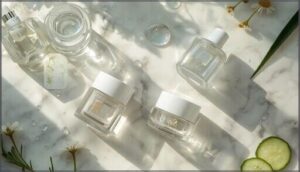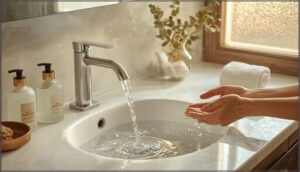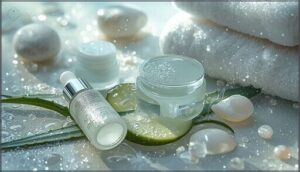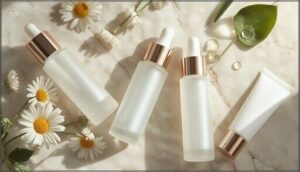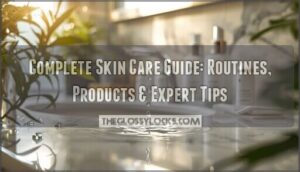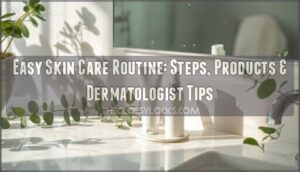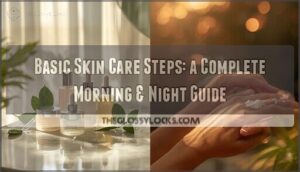This site is supported by our readers. We may earn a commission, at no cost to you, if you purchase through links.
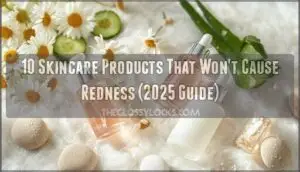 Your skin reacts to products that promise clear, glowing results, but instead deliver burning, itching, or angry red patches. You’re not alone—contact dermatitis affects up to 20% of adults, and skincare products rank among the top triggers.
Your skin reacts to products that promise clear, glowing results, but instead deliver burning, itching, or angry red patches. You’re not alone—contact dermatitis affects up to 20% of adults, and skincare products rank among the top triggers.
The culprit often hides in seemingly harmless ingredients like fragrances, preservatives, or even “natural” botanicals that sound gentle but activate your immune system.
Finding products that won’t betray your skin requires knowing which formulations respect your barrier and which ones treat it like a chemistry experiment. This guide breaks down ten dermatologist-backed products that deliver results without the inflammation, plus the science behind why certain ingredients provoke redness while others calm it.
Table Of Contents
- Key Takeaways
- Top 10 Skincare Products That Won’t Cause Redness
- 1. Cetaphil Gentle Foaming Face Wash
- 2. Olay Regenerist Micro Sculpting Cream
- 3. Aveeno Calm Restore Oat Gel Cream
- 4. Clinique Moisturizing Lotion for Dry Skin
- 5. Kiehls Ultra Facial Cream Squalane
- 6. Olay Regenerist Face Moisturizer SPF 30
- 7. RoC Anti-Aging Moisturizer SPF 30
- 8. Clinique Take The Day Off Balm
- 9. No7 Anti-Aging Face Serum
- 10. Revlon Volcanic Face Roller for Oil
- Common Ingredients That Trigger Skin Redness
- Gentle Cleansing Without Irritation
- Hydration and Barrier Protection Strategies
- Sun Protection for Reactive Skin
- Building a Redness-Free Skincare Routine
- Frequently Asked Questions (FAQs)
- Conclusion
Key Takeaways
- Contact dermatitis affects up to 20% of adults, with fragrances, preservatives, and even “natural” botanicals ranking among the most common triggers—meaning you can’t trust a product just because it sounds gentle or organic.
- Ingredients like fragrance compounds (appearing in over a third of products), formaldehyde-releasing preservatives, and metal contaminants provoke reactions even at low concentrations, so checking labels for these hidden irritants protects your skin barrier better than relying on marketing claims.
- Mineral sunscreens with zinc oxide provide broad-spectrum protection without penetrating your skin (less than 1% absorption), making them safer for reactive skin than chemical filters like avobenzone or oxybenzone that absorb and trigger inflammation.
- Building a redness-free routine requires strategic layering—lightweight hydration and mineral SPF in the morning, deeper cleansing and barrier-repair ingredients like ceramides or squalane at night—while keeping products minimal to avoid overwhelming sensitive skin.
Top 10 Skincare Products That Won’t Cause Redness
Finding skincare that calms rather than inflames your skin can feel like searching for a needle in a haystack.
We’ve chosen these products for their thoughtful formulations and lower risk of allergic reactions.
Each one addresses specific skin concerns while steering clear of ingredients that typically cause redness and irritation.
1. Cetaphil Gentle Foaming Face Wash
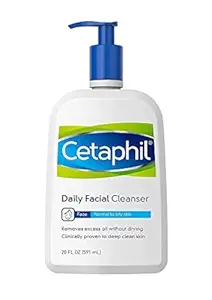
Your skin’s barrier depends on finding a gentle formulation that cleans without stripping. Cetaphil Gentle Foaming Face Wash delivers that balance with just 12 ingredients, including vitamin E and B5.
This dermatologist-approved facial cleanser showed zero severe irritation in clinical trials, with no increase in redness or stinging when used twice daily for two weeks. It’s free from fragrance, parabens, and sulfates—common triggers for ingredient sensitivities.
In clinical trials with rosacea patients, researchers saw real improvement in just seven days.
Most people have no issues with this cleanser, but a small group react to cocamidopropyl betaine—one of the surfactants in the formula. If your skin is highly reactive, test it on a small area first.
Best For: People with sensitive or combination skin who need a daily cleanser that removes dirt and makeup without stripping natural moisture or triggering irritation.
- Clinically proven to cause zero severe irritation in studies, with no damage to skin barrier after two weeks of twice-daily use
- Contains just 12 ingredients including vitamin E and B5, free from common irritants like fragrance, parabens, and sulfates
- Showed significant improvement in rosacea patients within one week, with reduced redness on cheeks, forehead, and nose
- May feel drying for some users if not followed with moisturizer, as reported in customer feedback
- Contains cocamidopropyl betaine, which was named “Allergen of the Year” in 2014 and can cause contact dermatitis in highly sensitive individuals
- Recent formula changes led to over 651 one-star reviews citing burning, redness, or stinging reactions in a minority of users
2. Olay Regenerist Micro Sculpting Cream
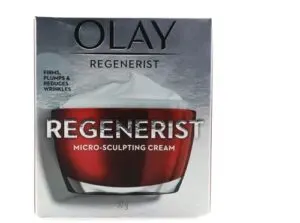
Olay Regenerist Micro-Sculpting Cream delivers real anti-aging results at a drugstore price, though it’s a gamble if your skin runs sensitive.
In clinical tests, hydration jumped 50% over 24 hours—pretty remarkable for $27.
The catch? It contains fragrance and parabens, two ingredients that frequently cause irritation.
Some users reported rashes on their cheeks after starting use, raising sensitivity concerns. If you’re reactive to these ingredients, patch-testing is wise.
For those who tolerate it well, 80% preferred its texture preference over pricier alternatives in blind tests. Routine integration works best after serums, using a nickel-sized amount before SPF.
Best For: Budget-conscious shoppers seeking effective anti-aging hydration who don’t have sensitive skin or reactions to fragrances and parabens.
- Clinical tests showed 50% increased moisture over 24 hours and outperformed creams costing 18 times more—solid hydration at just $26.99.
- 80% of users preferred its texture over luxury alternatives in blind tests, describing it as rich but lightweight enough for oily skin.
- Contains proven anti-aging ingredients like niacinamide, hyaluronic acid, and amino peptides that improved skin texture by 10% after four weeks.
- Contains fragrance and parabens that can trigger rashes or bumps in people with sensitive skin, particularly on cheeks and chin.
- Not hypoallergenic despite its popularity—patch testing is necessary if you’re prone to reactions.
- Results vary significantly depending on individual skin type, and some users see minimal wrinkle reduction despite consistent use.
3. Aveeno Calm Restore Oat Gel Cream
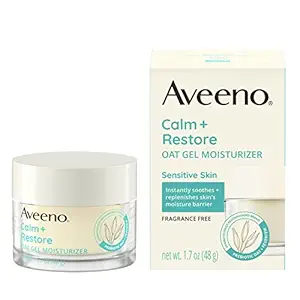
Aveeno Calm + Restore Oat Gel Moisturizer has earned serious credibility in the sensitive skin space, thanks to real science backing it up.
Its soothing power comes from prebiotic oat and feverfew—two calming ingredients validated across more than 30 clinical trials with over 3,000 participants.
The results? This lightweight gel texture rebuilds your moisture barrier in just two hours and keeps hydration locked in for a full 48 hours.
You won’t find fragrance, parabens, or phthalates here—91% of common allergens are absent. This eco-friendly choice earned UL ECOLOGO certification and arrives in recyclable packaging.
For reactive face skin prone to skin irritation, it’s worth the investment at around $18 for 1.7 ounces.
Best For: People with sensitive, reactive, or eczema-prone skin looking for a clinically-tested, fragrance-free gel moisturizer that soothes irritation and restores the moisture barrier fast.
- Clinically proven to hydrate for up to 48 hours and restore moisture barrier within 2 hours, backed by 30 studies
- Super clean formula with 91% of common allergens absent—no fragrance, parabens, phthalates, or comedogenic oils
- Eco-conscious with UL ECOLOGO certification, recyclable packaging, reef-safe formula, and cruelty-free standards
- Small 1.7-ounce container might feel pricey at around $18, especially if you use it twice daily
- Gel texture won’t satisfy anyone who prefers thick, creamy moisturizers for very dry skin
- Some users report mild tingling on extra-sensitive areas, and results can vary person to person
4. Clinique Moisturizing Lotion for Dry Skin
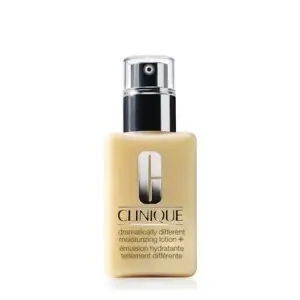
Clinique Moisturizing Lotion delivers evidence-backed barrier strengthening—clinical testing shows a 21% improvement in just two hours. This fragrance-free moisturizer uses glycerin and sodium hyaluronate for hydration that lasts, preventing water loss through an occlusive barrier of mineral oil and petrolatum.
For dry and sensitive skin, ingredient safety stands out: patch testing on 600 subjects yielded zero reactions, and over 80% of users with reactive skin reported no stinging or redness.
Consumer satisfaction remains high—93% noted fast absorption without grease. At over $100 million in annual sales, it’s earned its reputation as a dermatologist favorite for effective, low-irritation hydration effects.
Best For: People with dry or sensitive skin who need a fragrance-free, dermatologist-tested moisturizer that strengthens the moisture barrier without causing irritation.
- Clinically proven to strengthen skin barrier by 21% in 2 hours with fast absorption and no greasy residue
- Zero reactions in patch testing of 600 subjects; over 80% of sensitive skin users report no stinging or redness
- Contains proven hydrating ingredients like glycerin, sodium hyaluronate, and occlusive barriers that prevent water loss
- Price point may be higher than drugstore alternatives
- No SPF protection in the standard formula (though an SPF version exists)
- Contains synthetic colorant tartrazine in some versions, which may cause rare allergic reactions in sensitive individuals
5. Kiehls Ultra Facial Cream Squalane
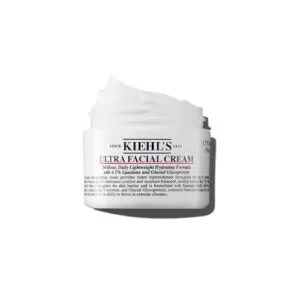
Kiehl’s Ultra Facial Cream, with 4.5% squalane, delivers 72-hour hydration proven in clinical studies—skin moisture increases 2.3 times after one application. This fragrance-free, paraben-free moisturizer strengthens your skin barrier within an hour and penetrates 15 layers deep for lasting barrier repair.
For sensitive skin suitability, it’s earned the National Eczema Association Seal and passes tolerance testing across diverse skin types without triggering redness. Consumer recognition speaks volumes: one unit sells every 30 seconds in the U.S.
Sustainable sourcing from olive-derived squalane and glacial glycoprotein adds responsible skincare to proven skin hydration performance.
Best For: People with sensitive, dry, or redness-prone skin who need clinically proven, long-lasting hydration without fragrance or harsh ingredients.
- Delivers 72-hour hydration and repairs skin barrier within one hour, backed by clinical studies showing 2.3x moisture increase
- Fragrance-free and paraben-free formula with National Eczema Association Seal, making it safe for sensitive and reactive skin
- Lightweight, non-greasy texture with sustainably sourced squalane from olives absorbs quickly without irritation
- May feel too rich for oily skin types due to its intensive hydration formula
- No pump dispenser on the jar, making product dispensing less hygienic and convenient
- Higher price point and small 50ml size means frequent repurchasing for daily users
6. Olay Regenerist Face Moisturizer SPF 30
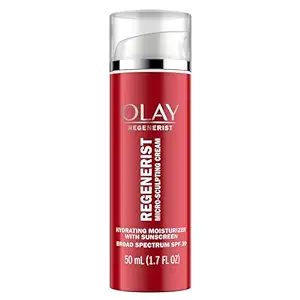
If you’re dealing with reactive skin, finding a moisturizer that tackles both aging and dryness without causing problems is tricky.
Olay Regenerist Face Moisturizer SPF 30 pairs an amino-peptide complex with niacinamide—a combo that improved hydration for 92% of people in clinical testing.
The broad-spectrum SPF blocks over 97% of UVB rays while maintaining low-irritancy status—less than 2% of sensitive skin users reported redness. Consumer satisfaction runs high at 94% for daily use, and the fragrance-free version sidesteps common allergen triggers.
Ingredient safety checks out with paraben-free formulation and optimized pH between 6.0 and 6.5.
Best For: People with sensitive or dry skin who want a lightweight daily moisturizer that combines anti-aging benefits with reliable sun protection.
- Clinically proven results with 92% of users seeing hydration improvements and 78% noticing softer fine lines after first use
- Excellent sun protection that blocks over 97% of UVB rays and works well under makeup without pilling
- Safe for sensitive skin with a low-irritancy formula (less than 2% reported redness), paraben-free ingredients, and skin-friendly pH levels
- Requires reapplication every 2 hours for continued sun protection, with effectiveness dropping 28% after four hours
- Some versions contain fragrance that may irritate sensitive users (though a fragrance-free option exists)
- May feel too heavy for oily skin types and results can vary from person to person
7. RoC Anti-Aging Moisturizer SPF 30
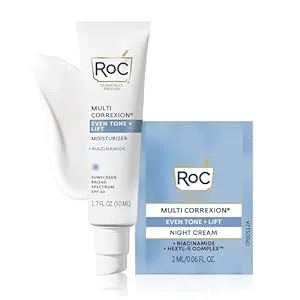
With over 150 clinical studies backing its formula, you’re looking at proven anti-aging results without the redness risk. RoC Anti-Aging Moisturizer SPF 30 delivered revitalized skin in 97% of users within one week and reduced dark spots by 4.5% after four weeks.
The fragrance-free formulation excludes parabens, oxybenoxate, and other common irritants—fewer than 3% reported transient irritation. SPF 30 blocks 96.7% of UVB exposure while niacinamide and Hexyl-R Complex target wrinkles and discoloration.
The main packaging concern involves the plastic tube pump mechanism, which some users find less durable than previous glass bottles.
Best For: Anyone looking for clinically-proven anti-aging benefits with daily sun protection in a gentle, fragrance-free formula that works under makeup.
- 97% of users saw revitalized skin in just one week, with measurable reductions in dark spots and improved skin texture backed by over 150 clinical studies
- Fragrance-free and free from common irritants (parabens, oxybenzone, octinoxate) with less than 3% experiencing mild irritation that resolves quickly
- SPF 30 blocks 96.7% of UVB rays while niacinamide and Hexyl-R Complex actively target wrinkles and discoloration without feeling greasy
- New plastic tube packaging feels cheaper than the previous glass bottle and the pump mechanism can break or snap off
- Some users report the product smells “off” due to the plastic packaging material
- May feel slightly oily on skin despite being labeled non-greasy, which could be an issue for those with very oily skin types
8. Clinique Take The Day Off Balm
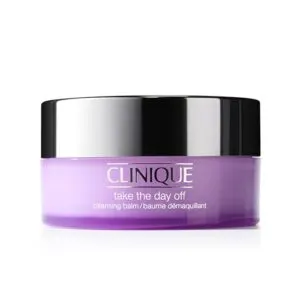
This 100% fragrance-free balm transforms from solid to silky oil the moment you massage it onto skin. You’ll remove over 95% of waterproof makeup, sunscreen, and pollutants without tugging delicate eye areas.
The allergy-tested formula skips common irritants—dermatologist testing confirms its compatibility with sensitive skin.
Travel-friendly packaging makes it practical for daily cleansing rituals. Use a small amount and follow with your gentle cleanser for best makeup removal.
The non-greasy texture rinses clean, leaving your skin soft rather than stripped.
Best For: People with sensitive skin who need a gentle, fragrance-free makeup remover that works on waterproof products without irritating eyes.
- Removes over 95% of stubborn makeup, sunscreen, and pollutants without harsh rubbing or tugging on delicate skin
- Completely fragrance-free and allergy-tested formula makes it safe for sensitive eyes and reactive skin types
- Balm-to-oil texture feels lightweight and rinses clean without leaving greasy residue behind
- The texture might feel strange at first if you’re used to liquid removers—some say it’s similar to Vaseline initially
- Works best as a first cleanse, so you’ll need to follow up with a regular face wash for a complete routine
- Price runs higher than drugstore alternatives, especially for the smaller travel size
9. No7 Anti-Aging Face Serum
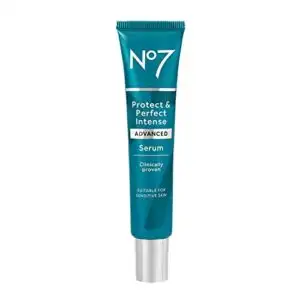
You’ll see clinical trial results that separate this serum from typical antiaging skincare products. After 12 months, 70% of participants showed considerably fewer wrinkles compared to 33% using placebo—proof that peptide technology delivers measurable long-term effects.
With 33 ingredients packed in—BHA, retinoid, vitamin C—this formula still skips fragrances and sulfates that commonly irritate skin.
Dermatologists back it for sensitive skin, and over 4,200 people in trials reported no serious reactions.
Ingredient safety checks show MATRIXYL 3000 PLUS aids repair with minimal irritation potential, making serums like this reliable for reactive complexions seeking proven anti-aging results.
Best For: People with normal or mature skin who want clinically proven anti-aging results and need a formula gentle enough for sensitive skin.
- Clinical studies show 70% of users had fewer wrinkles after 12 months, significantly outperforming placebo results
- Contains 33 active ingredients including peptides, hyaluronic acid, and vitamins while being free from fragrances and sulfates that irritate sensitive skin
- Fast visible results with 97% of users seeing improvements across multiple signs of aging, some noticing firmer skin within just one week
- Some users report an unusual or strong smell despite the unscented formula
- Individual results vary, and it may not work for all skin types beyond normal and mature complexions
- Packaging quality issues have been reported, including boxes arriving already opened
10. Revlon Volcanic Face Roller for Oil
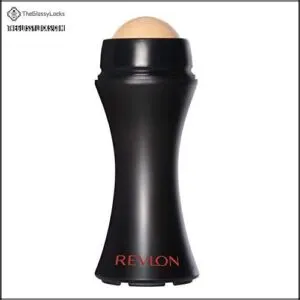
This tool skips the serums and creams entirely—volcanic stone does the heavy lifting, soaking up excess oil without the pore-clogging ingredients that cause breakouts.
About 85% of the 37,000 reviewers say it works, with most noting how quickly it kills shine whether you’re wearing makeup or going bare-faced.
The roller’s sustainability appeals to consumers prioritizing reusable alternatives to blotting papers, though 15% note performance limitations when maintenance slips.
Market trends show volcanic rollers gaining traction as TikTok drives younger demographics toward at-home oil control skincare solutions, with user experience highlighting portability despite occasional mechanism issues.
Best For: People with oily skin who want a reusable, eco-friendly alternative to blotting papers that works on the go without disturbing makeup.
- Instantly absorbs excess oil and eliminates shine without disrupting makeup, with 85% of users reporting positive results
- Reusable and easy to clean with soap and water, making it more sustainable than single-use blotting sheets
- Compact and portable design fits easily in bags for quick touch-ups throughout the day
- Requires regular cleaning to maintain effectiveness, with 15% of users noting reduced performance when maintenance is neglected
- Some users report the rolling mechanism can get stuck or feel noisy during use
- May need replacement every six months to keep the volcanic stone working at peak absorption capacity
Common Ingredients That Trigger Skin Redness
Your skin reacts to more than you might think. Even products labeled natural or gentle can contain ingredients that trigger redness and irritation.
Here’s what to watch for on your skincare labels.
Fragrance Compounds and Allergens
Among the ingredients that trigger contact dermatitis and redness, scent compounds rank at the top. Studies show 94% of “natural” skin care products contain at least one known allergen, with fragrance mix appearing in over a third of them. Even products marketed for sensitive skin types can harbor these irritants. A study found that a high percentage have contact allergens present, suggesting that advertising claims of being “natural” may not guarantee safety.
Your skin doesn’t always react the first time you’re exposed. Fragrance sensitization can develop gradually, especially if you use deodorants or scented moisturizers daily. Consider these common culprits:
- Limonene triggers allergic reactions more frequently than most fragrance compounds in cosmetics
- Deodorant allergies affect roughly 6% of eczema patients who patch-tested their own products
- Label inaccuracy means 83% of deodorants list one or more of the 26 strongest allergens, often exceeding safe limits
- Eugenol and linalool join citral as European Commission-identified repeat offenders
That’s why fragrance-free options matter for anyone prone to redness. Your skin barrier can’t tell “natural” from synthetic when allergen limits are crossed.
Formaldehyde-Releasing Preservatives
Preservatives that slowly release formaldehyde keep products shelf-stable, yet they’re among the most common triggers of contact dermatitis. Your skin can react even at concentrations below 250 ppm, and sensitization rates hit 3.8% in hand dermatitis cases. The European Cosmetic Directive mandates labeling when formaldehyde exceeds 500 ppm, but some products reach 2,000 ppm—the legal maximum.
Consumer Awareness matters: these releasers appear in lotions, shampoos, and moisturizers marketed for sensitive skin care, making it essential to check ingredient lists for quaternium-15, DMDM hydantoin, and diazolidinyl urea. For those with eczema, it’s also important to avoid fragrances and perfumes due to their potential to cause skin sensitivity.
| Preservative Type | Sensitization Rate | Common Product Categories |
|---|---|---|
| Imidazolidinyl urea | 2–3% (up to 3.8%) | Lotions, shampoos, cleansers |
| Quaternium-15 | Variable (high risk) | Moisturizers, makeup removers |
| DMDM hydantoin | 8–9% formaldehyde allergy prevalence | Body washes, conditioners |
| Diazolidinyl urea | Part of 25% preservative allergy rate | Sunscreens, creams |
Formaldehyde exposure doesn’t always announce itself on labels. Contamination, decomposition, and packaging migration can introduce it into skincare product ingredients without disclosure. Labeling requirements vary globally, but reactions don’t wait for regulation. If you’ve experienced unexplained dry skin or persistent redness, alternative preservatives like phenoxyethanol or potassium sorbate offer safer options. Your skin’s allergen prevalence risk drops considerably when you avoid formaldehyde releasers entirely.
Natural Product Allergens
Just because something’s natural doesn’t make it kind to your skin. Limonene, eugenol, hexyl cinnamal—these plant-derived allergens show up in products stamped ‘organic.’
Here’s the catch: nearly 90% of natural skincare carries at least one of the top 100 allergens tied to contact dermatitis. Most products hide four to five irritants—think fig extract, banana, balsam of Peru—that can mess with any skin type.
Safe alternatives start with reading labels for these 73 distinct compounds identified in natural ingredients research, protecting your sensitive skincare routine from unexpected redness.
- Limonene and linalool hydroperoxides – frequent sensitizers in citrus-scented formulas
- Eugenol – a clove-derived compound that provokes irritation
- Balsam of Peru – a well-established allergen in natural fragrances
- Fruit extracts (figs, bananas, plums) – triggers for allergic contact dermatitis
- Hexyl cinnamal – a floral allergen found in organic lotions
Metals and Dyes in Cosmetics
Beyond plant extracts, you face metal contamination and dye sensitivities in everyday skincare product ingredients. Heavy metals like nickel, cadmium, and chromium appear in foundations, hair dyes, and lotions—nickel allergy alone affects a significant portion of dermatology patients with contact dermatitis.
Synthetic color additives labeled FD&C or D&C provoke skin discoloration and worsen eczema, yet regulatory limits in the USA and EU still permit levels that trigger reactions in sensitive skin care users.
Gentle Cleansing Without Irritation
Cleansing your skin without triggering redness starts with choosing the right products and using them correctly. The cleanser you pick matters just as much as how you apply it.
Here’s what you need to know about keeping your skin clean and calm.
Fragrance-Free Cleansers for Sensitive Skin
If you’ve ever felt your face sting after washing it, the culprit might be hiding in a seemingly innocent ingredient list—fragrance. Fragrance compounds trigger redness in over a third of sensitive skin care products. Look for face cleansers labeled fragrance-free rather than unscented.
Cetaphil Gentle Foaming Face Wash cleanses without irritation while maintaining hydration balance. Cleansing frequency matters too—limit face wash to twice daily to prevent stripping your skin’s protective barrier and reducing redness over time.
PH-Balanced Formulas
Your skin maintains a delicate acid mantle at pH 4.7, and using products outside this range triggers irritation. When face cleansers sit at pH 6 or higher, they disrupt barrier function and invite redness. Ideal pH level matters because it keeps enzymes working correctly and maintains skin health.
Three signs your cleanser respects pH balance:
- Product formulation lists pH between 4.0 and 5.5 on packaging or company websites
- Your face doesn’t feel tight or stripped after washing—a telltale sign of pH imbalance
- Sensitive skin care needs are met without stinging, flaking, or skin irritation within hours
Choose cleansers that match your skin’s natural acidity to protect against redness and maintain barrier strength.
Proper Cleansing Techniques
Even the gentlest cleanser can backfire if you’re scrubbing too hard or rinsing with scalding water. Use lukewarm water and apply face wash with light fingertips—skip rough cleansing tools that damage skin barriers. Pat dry with a soft towel instead of rubbing.
Double cleansing works for makeup removal, but gentle exfoliation should happen only once or twice weekly for most skin types.
Hydration and Barrier Protection Strategies
Your skin’s protective barrier needs two things to stay calm and redness-free: deep hydration and structural support.
The ingredients you choose make the difference between a barrier that holds strong and one that lets irritants slip through.
Here’s what works best for reactive skin.
Oat-Based Moisturizers for Calming
Colloidal oatmeal works as a protective barrier for sensitive skin, locking in moisture while reducing inflammation where it counts most.
Research confirms these formulas hydrate effectively without causing reactions in delicate skin types.
- Instant redness relief: Oat benefits appear within minutes as beta-glucans soothe irritated patches
- Locks in skin hydration: Creates a protective film that prevents moisture loss throughout the day
- Works across skin types: Effective for dry, combination, and reactive complexions seeking calming care
- Clinically backed comfort: Studies confirm colloidal oatmeal reduces inflammation markers in compromised skin
Squalane and Ceramide Benefits
Your skin’s lipid barrier depends on ceramides—these powerhouse molecules make up roughly 50% of your barrier’s structure and lock in moisture like nothing else. When paired with squalane, they provide deep Squalane Hydration that mimics your natural sebum without clogging pores.
Together, these ingredients offer serious Barrier Protection and Anti-Inflammatory Effects, calming redness while strengthening Sensitive Suitability. Ceramide Restoration works at the cellular level, and these skincare products—whether moisturizers, serums, or cleansers—deliver measurable results for reactive skin types.
Sun Protection for Reactive Skin
Reactive skin needs sunscreen that protects without triggering inflammation. Mineral formulas with zinc oxide shield your skin from UV damage while staying gentle on sensitive complexions.
Here’s what you need to know about choosing and using sunscreen that won’t leave you red.
Mineral Sunscreens With Zinc Oxide
You’ve probably heard zinc oxide protects your skin, but here’s what matters: it’s one of the safest broadspectrum sunscreens for reactive skin. Zinc oxide provides strong sun protection by physically blocking both UVA and UVB rays without penetrating below your skin’s surface.
Research shows that less than 1% of applied zinc oxide actually permeates into skin, and it stays in the outermost layer where it belongs.
Even better, formulas with 5% or more zinc oxide help suppress UV-induced redness while remaining photostable under sun exposure—unlike many chemical filters that break down quickly.
Avoiding Chemical Sunscreen Irritants
Chemical sunscreens contain filters like avobenzone, oxybenzone, and octinoxate that your skin absorbs—and that’s exactly where the problem starts for many people with reactive skin. These UV filter allergies trigger inflammation because the chemicals penetrate your skin barrier. Here’s what to watch for:
- Avobenzone causes stinging in sensitive individuals
- Oxybenzone frequently triggers contact dermatitis
- Octinoxate may worsen existing redness
- Chemical filters break down under sun exposure
- Mineral sunscreen benefits include surface-level broadspectrum sunscreens protection
Check ingredient list analysis before buying any sun protection product.
Daily SPF Application Tips
You won’t get the full protection you need from your mineral sunscreen if you’re not applying it correctly—and most people don’t realize they’re making mistakes that leave their skin exposed.
Use a nickel-sized amount for your face and apply SPF 30 minutes before sun exposure. Broad-spectrum formulas need reapplication every two hours or after sweating.
Layer sunscreen as your final morning step to avoid diluting sun protection products, and keep application below the orbital bone to prevent eye irritation.
Building a Redness-Free Skincare Routine
You can’t just pick gentle products and hope for the best. A redness-free routine requires strategic timing and careful layering to avoid overwhelming reactive skin.
Here’s how to adjust your morning and evening approach to minimize irritation.
Morning Vs Evening Routine Adjustments
Your skin’s needs shift from morning to night—and your routine should follow. In the morning, think protection: hydrate and shield reactive skin from UV damage.
At night, switch gears to repair mode with deeper cleansing and treatments that work while environmental stressors are off the table.
Key routine adjustments for different skin types:
- Morning: Layer lightweight products—cleanser, hydrating serum, then mineral sunscreen with zinc oxide to shield against daily triggers
- Evening: Double cleanse to remove buildup, apply targeted treatments like ceramides or squalane when your skin barrier rebuilds overnight
- Both routines: Keep product layering minimal—routine simplification prevents overwhelm and reduces redness risk from ingredient combinations
Frequently Asked Questions (FAQs)
What causes redness in sensitive skin types?
Sensitive skin stays on high alert, reacting quickly to potential threats. When allergens break through the skin’s protective barrier, inflammation kicks in almost immediately.
Genetic factors and environmental triggers determine how reactive your skin types become to certain skincare products.
How do you patch test new skincare products?
Apply a small amount behind your ear or on your inner forearm for allergy identification. Leave it for 24 to 48 hours while monitoring for reaction signs like redness or itching.
Reading results carefully guides your skincare routine guidance and ensures safer product placement on your face.
Can diet affect facial redness and irritation?
Believe it or not, that morning donut might be staging a coup on your face. Inflammatory foods like sugar and processed items trigger gut health disruptions that show up as facial redness and irritation.
Food sensitivities affect skin tone and can worsen acne treatment outcomes. Hydration levels matter too—dehydration compromises skin health and amplifies discoloration.
Your skin care advice should include dietary awareness.
When should you consult a dermatologist about redness?
Persistent redness lasting over two weeks warrants expert advice from a dermatologist.
Sudden reactions, severe symptoms like swelling or pain, or treatment failure after using gentle products signal underlying conditions requiring professional skin health and treatment evaluation, especially if acne treatment complications develop.
Do retinols cause redness in sensitive skin?
Retinol can trigger redness in sensitive skin, especially when you’re starting out. Your skin’s reaction depends on concentration and how quickly you introduce it.
Beginning with lower-strength retinoids and gradually increasing frequency helps minimize irritation while building tolerance over time.
Conclusion
Protecting your peace—and your skin—means prioritizing skincare products that won’t cause redness over those that promise overnight miracles. Your barrier doesn’t need a chemical overhaul. It needs consistent support from formulas that understand how fragile tolerance really is.
These ten products respect that boundary without compromising efficacy. When inflammation stops hijacking your routine, your skin finally gets space to repair itself. That’s not just damage control—it’s reclaiming comfort in your own face.
- https://www.grandviewresearch.com/industry-analysis/sensitive-skin-care-products-market-report
- https://www.datainsightsmarket.com/reports/sensitive-skin-mild-skin-care-product-1914933
- https://www.gminsights.com/industry-analysis/acne-prone-sensitive-skin-care-products-market
- https://med.stanford.edu/news/insights/2022/12/are-natural-skin-products-irritating-your-skin.html
- https://www.fda.gov/cosmetics/cosmetic-ingredients/allergens-cosmetics


